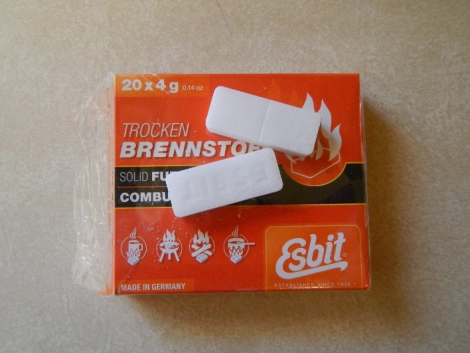
The following article is not meant to be, nor do I claim it to be, an in depth controlled scientific study on the efficiency of Esbit tablets. There are already a lot of people out there who spend an awful lot of time finding the most efficient way to heat water while on the trail. I’m not one of those people. Instead, I’m simply looking at the merit of using 4g Esbit tablets in place of the traditional 14g Esbit tabs. I don’t hear a whole lot of talk about the 4g tabs and I’m not sure why. If you look at the Esbit systems available both commercially and cottage, they all appear to be tailored to the 14g tabs.
Esbit Tablet Overview
I have heard some mention the 4g tabs are harder to find than the 14g tabs. Maybe I’m fortunate in that two local outfitters in my town carry the 4g tabs, so I have never experienced difficulty acquiring them. One difference between the packaging of the 4g vs 14g is the 4g tablets are not individually packaged. With the 14g, each tab is individually packaged in a plastic blister with foil backing. This is something I don’t care for as once you use the 14g tab, you have the extra bulk/weight of the empty blister pack to carry around with you. Also, in my experience, the blister really seals in the controversial Esbit stink. Some people are more sensitive than others but I notice a significant difference in smell between the 14g and 4g tabs, with the 4g really not having all that strong of odor. This is likely a result of the off-gassing which occurs due to the 4g tabs not being individually sealed. I do carry my 4g tabs in a small Ziploc bag which adds probably 1g of weight to my cook kit. This protects both the tabs and my cook pot, as I stow the tabs inside my pot.
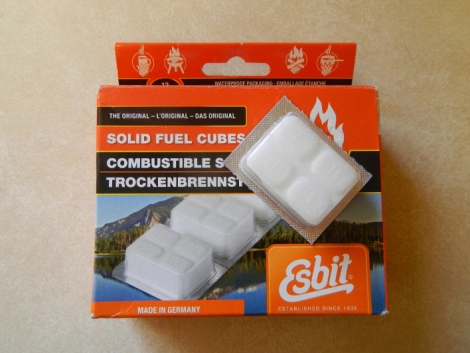
Another thing I have heard against the 4g tabs is they end up costing more per gram than the larger 14g tabs. Honestly, I have not done the math on this, and I’m all for saving money, but I can’t imagine the cost difference is that significant and I don’t even consider it. And I do have to chuckle when I realize this complaint is coming from some people who have spent upwards of $700 on just their cuben shelter alone.
Esbit 4g vs 14G Tablet Comparison
So for this write up, I decided to do some comparison burns using 4g and 14g Esbit tabs. What I ended up with, in my non-scientific way, is either works just fine to heat water but there are some subtle differences between the two, including smell and amount of residue left behind. For those who have never burned Esbit, it leaves a dark, tarry residue on the bottom of your pot. This is another complaint I have heard about Esbit, but having the bottom of my cook pot get dirty is of zero concern to me. That’s another thing I have to chuckle and shake my head about. If someone is going to get really bent out of shape about a dirty cook pot bottom, it may be time to stop and re-evaluate a few things. I do recommend to store your pot in a Ziploc bag or stuff sack to keep the residue from getting on other contents of your pack.
I don’t really cook when I am on trail. Instead I simply heat water for warm drinks or to rehydrate meals. I purposely package my meals to only require between 1 to 1 ¾ cups water, typical is a cup and a half. The standard for stove testing (which remember, this is not) seems to be to boil 2 cups of water but I never boil water nor do I need 2 cups. I find my meals rehydrate just fine with hot water, not boiling and warm drinks do not require boiling water. The only situation I can think of where you would need to boil water is to make it potable and that’s not something I am going to get into as you would need to carry a lot of Esbit and there are far better ways to treat water.
Having said all that, I did decide to use 2 cups of water for each test burn, just because. Let’s start with the 4g tabs. For the burn I used 2 four gram tabs in a simple titanium burner/holder. The burner is nothing more than Ti foil (I can’t remember what gauge) with two sides bent upwards. I have tried quite a few MYOG Esbit burners and this simple design has proven quite effective.

Cook Kit and Burn Times
The rest of the cook kit consists of a Heineken Keg can and a Titanium Caldera Cone.
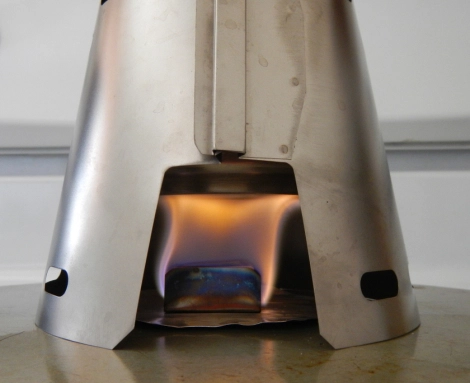
Burn time was around 14 minutes, that’s pretty darn good for 8grams of Esbit. I’ve done a fair amount of experimenting with this set up to optimize burner and distance with the 4g tabs. The total 8grams of Esbit did not bring 2 cups to a boil but it got the water more than hot enough to burn the heck out of you if you spill it in your lap or to rehydrate a meal. I recommend the latter.
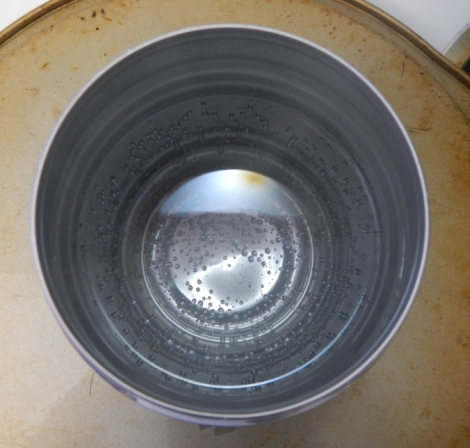
Something I have noted about the smaller 4g tabs is they not only tend to burn cleaner and with less smell but also burn more completely. There is not as much residue left in the burner as compared to the 14g tabs.
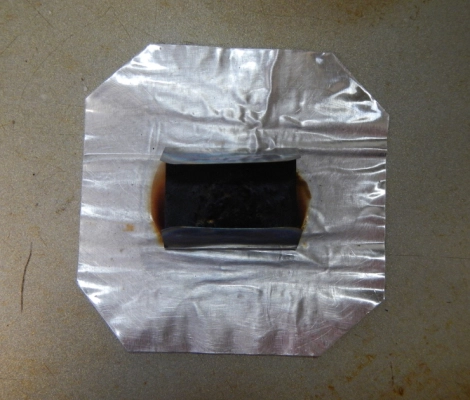
With this burner design, there is a small amount of run off from the Esbit liquidizing as it burns. This is also significantly less with the 4g tabs compared to the 14g. A burner with a tray design, like the BGET will help to contain the liquid as it burns and is more necessary with 14g tabs than the 4g.
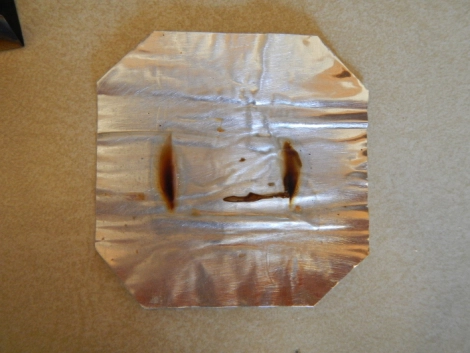
Here is a photo of the clean bottom of the can before the burn.
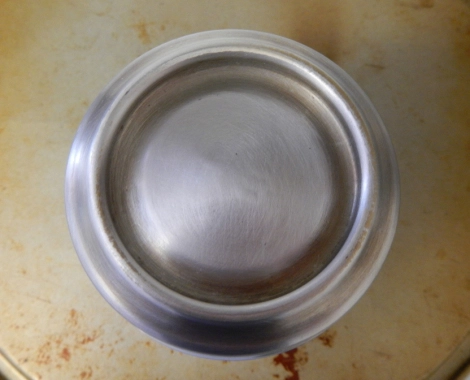
And here is a photo of the bottom of the can after heating 2 cups water with 2 four gram Esbit tabs. There is only a small amount of residue left from the burn.
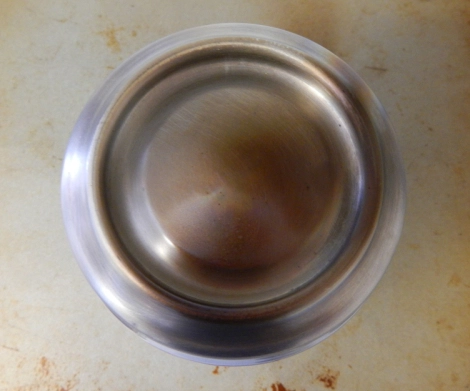
OK, lets do a burn with 2 cups water and a 14g tab.
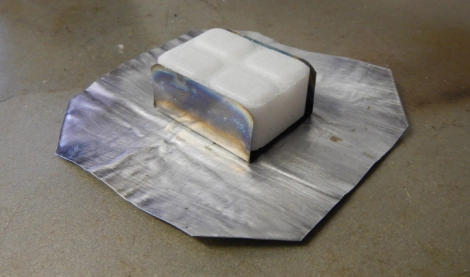
One thing to note is the 14g tab took a bit more effort to light than the two 4g tabs. One thing you can do to aid this is scrape the top of the 14g tab with a knife and the shavings really help to get it to light quicker.
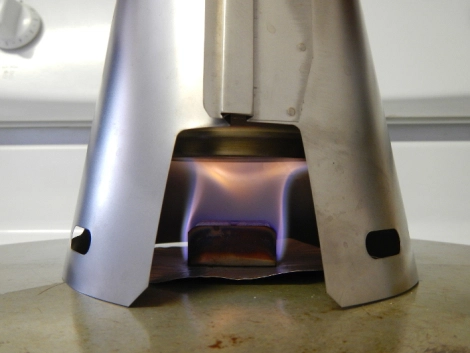
So in order to be fair with this comparison, once the water reached similar shrimp eyes (I warned you this wasn’t scientific), I removed the pot and blew out the Esbit. Burn time was around 10 minutes. There was quite a bit of the 14g tab left. Also noted a much stronger smell while burning.
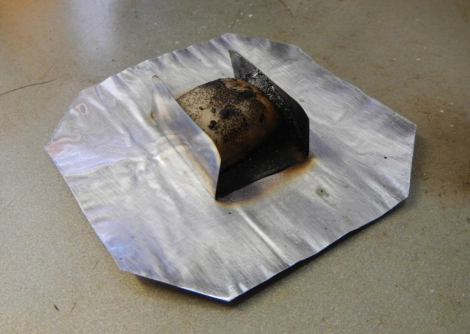
Now this partial tab can be saved and used again later, and it lights much easier than the unburned tab. Note also in the photo above there is very little Esbit lost at this point due to liquid run off.
Here is the water after this first burn. Once again, it had cooled off a bit so I could get a photo.
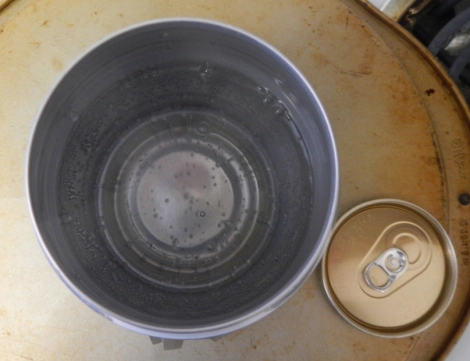
So opinion on the left over tab is going to come down to personal preference. Personally, I don’t care for the left over tab, I would rather completely consume all the fuel in one burn.
Here is a photo of the bottom of the pot before the 1st burn with the 14g tab.
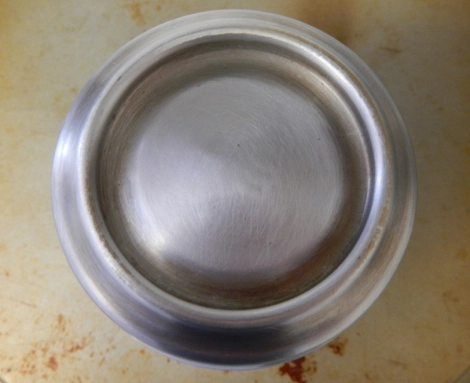
And here is the bottom of the pot after the 1st burn with 14g tab.
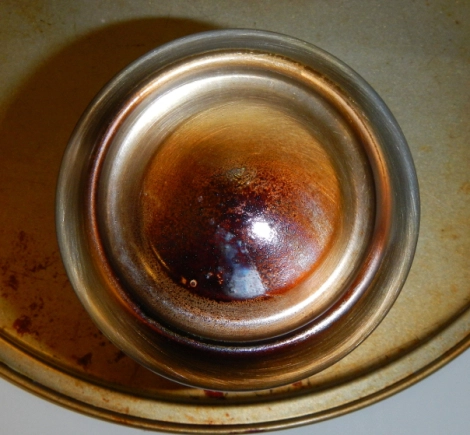
Significantly more residue than with the two 4g tabs.
So I cleaned everything up and did another 2 cup burn with the remainder of the 14g tab. This burn lasted about 8 minutes and heated the water to approximately the same point.
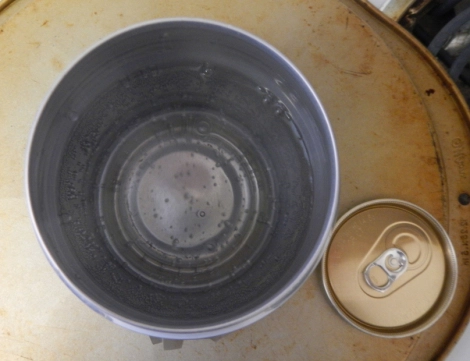
Here is a close up of the burner after completely burning the 14g tab. It’s hard to make out from the photo but there is a lot more chunky residue left, indicating to me, a less complete burn than with the 4g tabs.
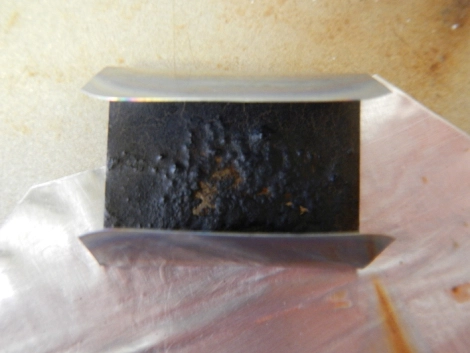
Also note significantly more loss due to run off after this second burn. This is why I would recommend a tray type burner for the larger 14g tabs.
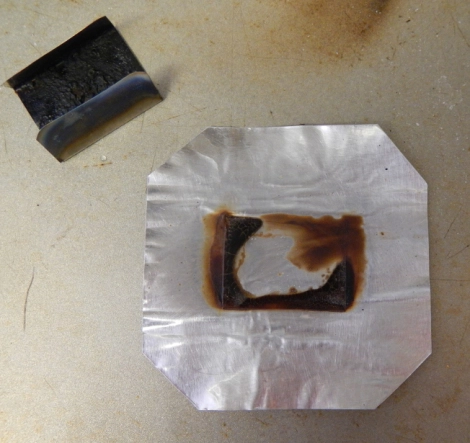
Results of 4g and 14g Tablet Burn Times
So in comparing the 4g and 14g tabs, the differences are really not all that significant comparing burn time and amount to achieve similar results between the two. My conclusion would be a continued preference for the 4g tabs mainly due to how much cleaner and completely they burn. Also, with experience, I have gotten pretty good at judging how many of the 4g tabs I need for each burn, based on environmental conditions and water volume. In winter, for example, I will typically use 2 1/2 to 3 four gram tabs to heat 1 1/2 – 1 3/4 cups water. On a calm summer evening, I may use only 1 1/2 tabs for the same amount of water. The 4g tabs are pretty easy to cleanly break in half as opposed to the 14g tabs. And while the 14g tabs are scored to be able to break in to 1/4’s, good luck with that, it’s not easy. Pack space to me is always a commodity and the 4g tabs take up much less space than the 14g, and let’s not forget the left over packaging/waste of the 14g tabs.
So in summary, what I prefer about the 4g tabs:
- Cleaner burn
- More complete burn
- Less smell while burning
- Less smell while not burning
- Easier to dial in exactly how much you need for the burn
- Easier storage, less bulk
- No left over packaging to carry around
- No need for a special burner to contain the liquid
- Easier to light
And regarding Esbit in general, if you have never used it, I recommend giving it a try. It is simple to use and arguably one of, if not the, safest fuels available. I was a dedicated alky stove user until three years ago when I first used Esbit and since then, I have used it exclusively. I wouldn’t even consider going back to alcohol at this point. The only thing simpler and easier than Esbit is going no cook but that is a discussion for another time.
Disclaimer: I have no association with any person, entity or corporation involved with the manufacturing or distribution of Esbit products, I just like the stuff.
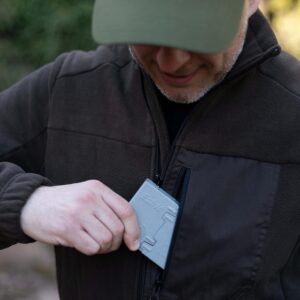
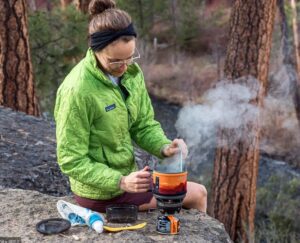
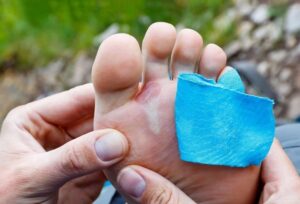
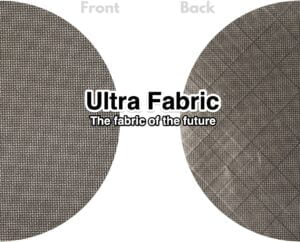


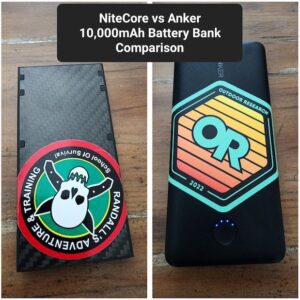
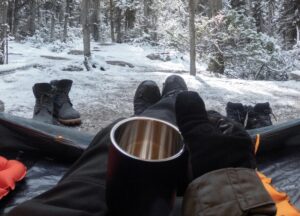
I have been using the 4g Esbit tabs for a while now and I completely agree with the author’s findings. They burn cleaner and more completely compared to the 14g tabs. I also appreciate that they don’t have a strong odor like the 14g tabs. Overall, I find the 4g tabs to be more efficient and convenient for my backpacking trips.